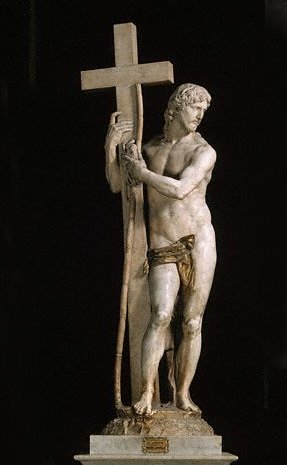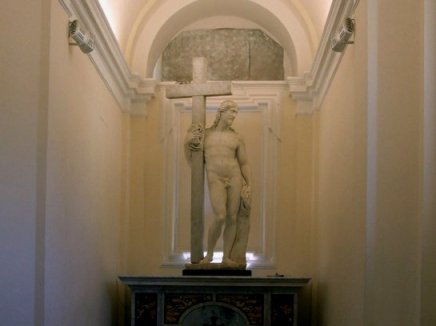|
Covering up - Michelangelo and Masaccio |
|
| In September 2011 my wife and I visited the church of San Francesco in Arezzo. Our object was to see the frescos by Piero della Francesca in the Cappella Maggiore; we hadnít known that beneath the church was a display space featuring regular art exhibitions. At the time there was an exhibition based on the writing of Vasari that Iíve suggested elsewhere would be a sell-out in London or New York. The highlight of the show was a sculpture by Michelangelo. I photographed it (when the attendant was looking the other way) although at the time I wasnít aware of its history or significance. |
|
|
|
|
| So
Ė what is it? In 1514 Michelangelo, then in Rome, signed a contract to carve a nude Risen Christ holding a cross. He made a start, but came to a halt when the marble was found to be faulty Ė a black vein in the area of the face. By 1516 Michelangelo had given up on it and had headed for Florence. By 1517 the client started demanding his sculpture. The following year Michelangelo started again with a fresh piece of marble. Untypically, Michelangelo got on with the job, and it was almost done by 1520. It was shipped off to Rome, where it was to be finished off by Piero Urbano. It seems that this didnít go well, and a third sculptor, Federigo Frizzi, took it on and finished it off. By 1521 it was in its place in Santa Maria sopra Minerva in Rome where it remains Ė Here it is (On the left, below.) Another photograph of the sculpture we saw in Arezzo is on the right. |
|
|
|
|
|
There are clear differences between the two: the position of the left
arm is an obvious one - and the prudish covering up of the Santa Maria
sopra Minerva version with a bronze loincloth. The sculpture in Arezzo was the first version, the one rejected by Michelangelo. It has a rather complicated story. It was handed over to the original client who kept it in his garden for a while. It was in an unfinished state and so heavily worked on by at least one other sculptor. Then in 1607 it was put up for sale and disappeared. At some point it ended up in the remote church of S. Vincenzo Martire at Bassano Romano, where, according to Irene Baldriga |
|
|
|
|
|
So why is the version in Rome covered with a loincloth? It certainly wasn't Michelangelo's idea, or he would have carved one. Before we attempt an answer to this, let's follow Michelangelo back to Florence. |
|




